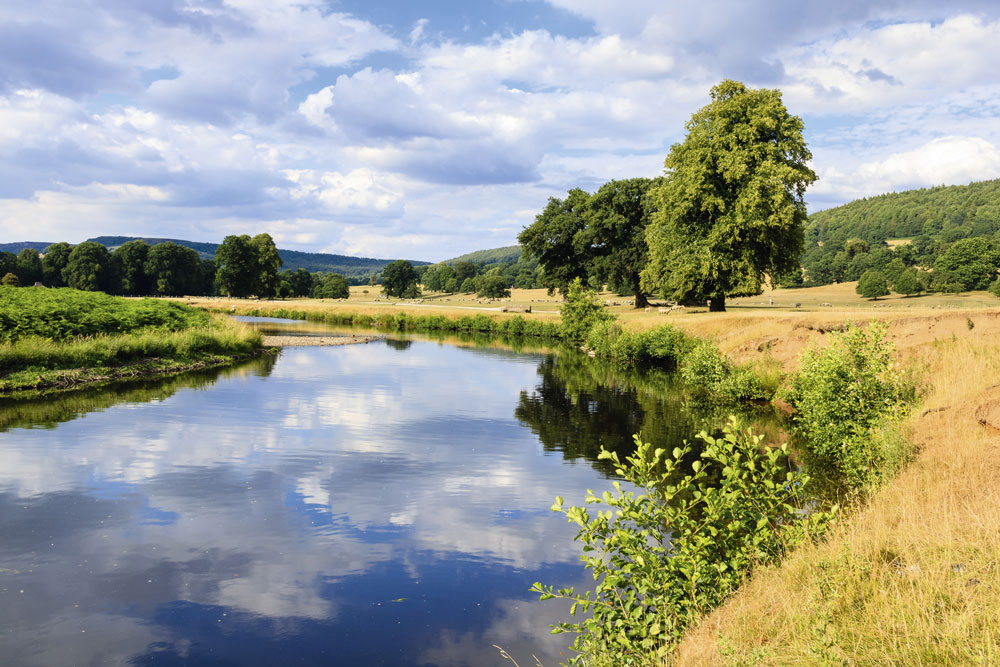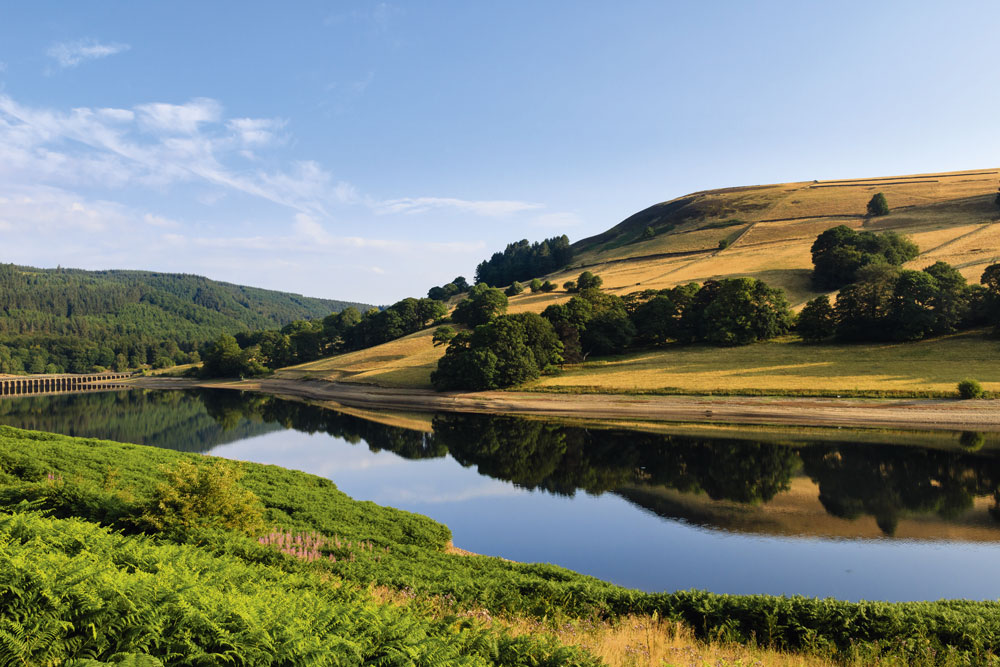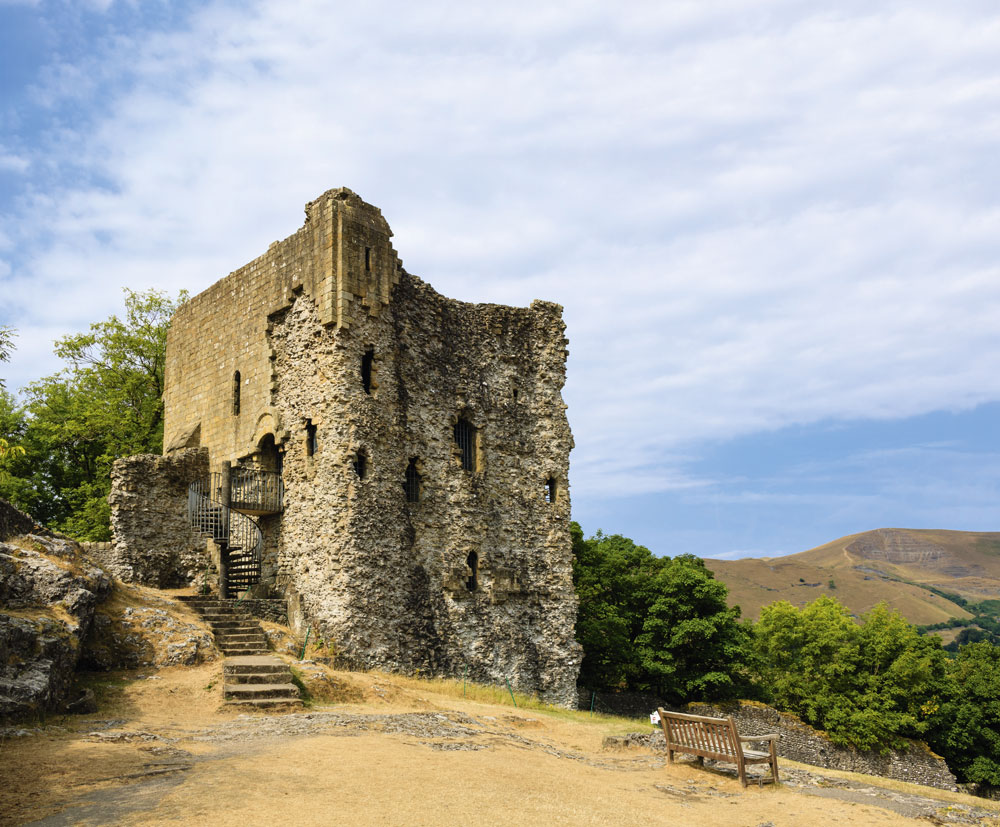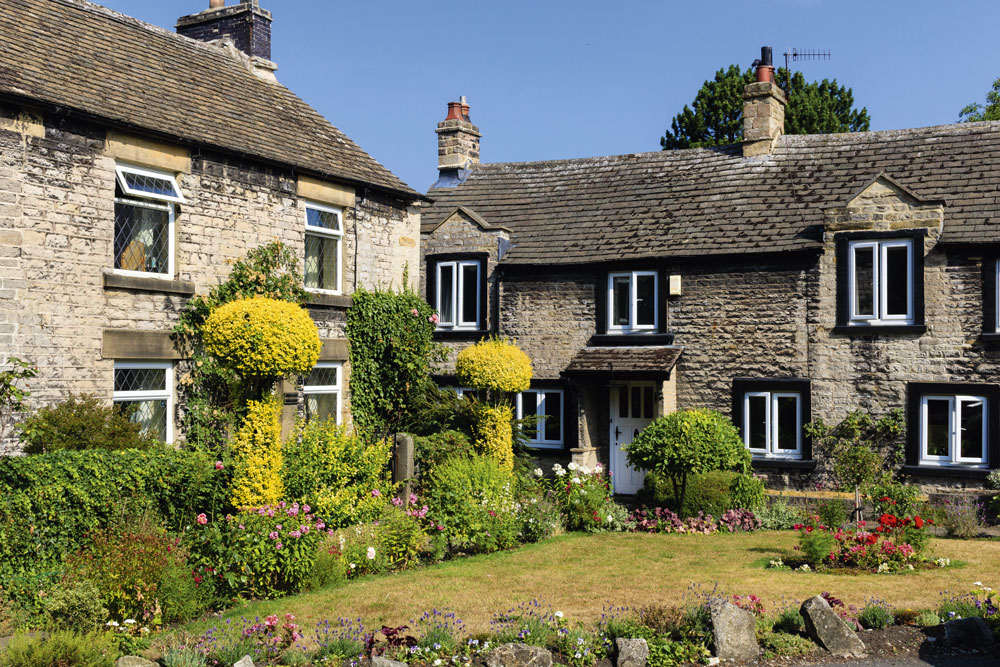Motorhome travel: Exploring the Peak District
Words & Photos: Felicity Martin
It’s 8am when we stop for breakfast at a picnic site near Thorpe, just north of Ashbourne. Our early start to avoid traffic jams through roadworks on the M5 and M6 have paid off and we breathe a sigh of relief at having reached the Peak District without the frustrating motorway delays we experienced on our way south. The temperature is in the mid-20s and we’re grateful for a shady spot by a cycle trail along a disused railway line, already being used by cyclists and runners.
It’s high summer and we plan to explore the eastern edge of the National Park, which we hope won’t be as crowded as some of the more central honeypots. We start by heading to Bakewell for tourist information and shopping.
Online, I identify the Agricultural Business Centre (on Agricultural Way, off the Matlock Road) as a roomy place to park. We arrive to find hordes of people and cars – the street market and cattle market are held on Mondays – so we use extra parking in a field just short of the centre. An easy walk past all the agricultural activity and over a footbridge across the River Wye takes us to the busy town centre and an enormous Co-op.
Wandering beside the river to the medieval bridge, we’re amazed by the big rainbow trout in the river; they swim close under the Canada geese, each quite unperturbed by the other’s presence In the tourist information centre I’m delighted to find Rocks & Edges by a friend, Dennis Kelsall; it’s a pocket-sized walks guidebook that will help us explore on foot.
Locals advise us to try Bakewell pudding rather than Bakewell tart, so we duly find a seat in the courtyard of the Old Original Bakewell Pudding Shop and sample the local produce over coffee. With cream, of course!
To add a bit of class to this trip, we’re starting off at one of England’s most prestigious stately homes. I’ve managed to get a last-minute booking for a pitch at Chatsworth Caravan and Motorhome Club site, which is located in the old walled garden of Chatsworth House.
In the afternoon we take the bikes through a gate at the back of the site for a ride around Chatsworth Park. There are sheep (and their droppings!) everywhere, serving as four-legged lawn mowers. Many are lying under the cool canopies of the fat old oaks scattered around the parkland.
Chatsworth House looks impressive in the late-afternoon sunshine. Its setting appears marvellously natural but was carefully designed and planted by Capability Brown, who added a weir to the River Derwent to create a serpentine lake. He even moved the existing village and heightened the hill between it and the house to hide the peasants from view.

The next day we start with coffee and muffins in Chatsworth’s Stables courtyard. A board on the wall details the Cavendish family line. This runs unbroken from the mid-1500s – when they bought the land and started the house – to the current Duke and Duchess of Devonshire.
I’ve pre-booked a ticket for Chatsworth Gardens. Although I will be missing 30 elegant rooms in the house’s interior, I’m glad to be outside on such a glorious day and, with 105 acres to explore, there’s plenty to keep me occupied. Andrew has elected to walk in Stand Wood, a wilder bit of the estate, with our collie, Braan.
On entry I book a place on a free 15-minute tour up the Belvedere, a viewpoint pavilion that rises above the north wing of the house. On the way up the stairs my eye is caught by what appears to be a stained glass window, but turns out to be thin slivers of Blue John, an amethyst-coloured mineral occurring locally. From the top we enjoy a superb bird’s-eye view of the gardens and park.
Our guide tells us that the window frames on the west face of the house are painted in gold leaf to glint in the setting sun, so I begin my walk around the gardens by heading that way to the Emperor Fountain in the Canal Pond. Constructed for a planned visit of the Emperor of Russia, it was then – at 296ft (90m) – the world’s highest gravity-fed fountain.
Further up I visit the maze on the site of the Great Conservatory, which was the largest glasshouse in the world and had an elaborate system of rails, tunnels and flues to bring in 300 tons of coal each winter in order to heat it invisibly. I am simply amazed by the extravagance of the garden features; each one must have cost a fortune to build.
Later I bump into ‘Joseph Paxton’ and his wife – actually, costumed characters playing the parts. As head gardener for the sixth duke, he built the Great Conservatory and many other features, including a giant rock garden and a cascade, which is fed by ponds and an aqueduct in Stand Wood. ‘Joseph’ tells me that he was later commissioned to build Crystal Palace.
With another scorching day in prospect, we make an early start for a walk along Baslow and Curbar Edges. The route climbs steeply through the old stone houses of Curbar village and past the graves of the Cundy family, who died of plague in 1632.
Gaining higher ground, we pause at a bench for a drink while enjoying the view south to Chatsworth. Nearby we visit the Wellington monument, erected in 1866 to commemorate the duke’s heroic exploits and the Eagle stone, a large tor sitting on the moorland.
Then we take the path that runs along the edge of the millstone grit escarpment, with excellent views over Curbar and Calver and up Stoney Middleton Dale to Eyam.
The rock face below us has been quarried in places and we spot a half-cut millstone below the crags. A viewpoint indicator names the peaks on the skyline, with distant Kinder Scout just visible. After we go for cooling drinks in the dog-friendly bar of the Derwentwater Arms in nearby Calver, where we had a lovely meal the previous evening.
Our afternoon is spent in Eyam, where we browse interesting displays in the Market Hall about the village’s plague history and lead mining heritage.
When the plague was raging in London in 1665, it was accidentally carried here in some flea-ridden cloth delivered to a tailor. In the outbreak that followed a third of the parish’s population died, but a self-imposed village quarantine prevented it spreading to neighbouring places.
It is such a picturesque place now that it is hard to imagine the suffering that must have happened. At one farm a mother had to bury her husband and six children but remained uninfected herself.
We use the book I bought to do another excellent walk along the Millstone Edge from Longshaw Lodge car park.

This leads past the visitor centre and a plaque that commemorates the passing of Longshaw Estate into the care of the National Trust in 1931 and the establishment of the Peak District National Park, England’s first, in 1951.
The route runs down pretty Padley Gorge, through lovely oak wood where the spooky-looking trees have bulbous burrs and twisted, convoluted branches. Then we climb past millstone grit quarry workings to Surprise View to enjoy the prospect west over Hathersage to the Hope Valley.
Our path leads along the cliffs of Millstone Edge, then across the heather moorland to two weathered tors, Over Owler and Mother Cap. A heathery gully takes us back to Padley Gorge. This time we go upstream beside babbling Burbage Brook, which is now lined by picnicking families. We return through estate woodland to the visitor centre café after a very varied and enjoyable walk.
Finding the weather sweltering, we make an early start the next day before the heat builds up. We drive up the attractive Upper Derwent Valley, with its chain of reservoirs. The minor road is empty but will probably be full of visitors within a few hours.
We breakfast in a car park overlooking Ladybower Reservoir as a dawn mist clears revealing a deep blue sky and dazzling reflections.
It’s still early when we move on to Castleton, at the top end of the Hope Valley, and draw up in an almost empty car park. After peering into Peak Cavern, below a great cleft in the hillside, we wander up Cave Dale, a dramatic limestone valley with crags on its steep sides. High above, we can see the keep of Peveril Castle.

Later I visit the castle, while Andrew takes Braan paddling in a shallow stream to keep cool. Interesting displays detail its history, which begins soon after the Norman conquest in 1066.
From the eleventh to the sixteenth centuries it was the administrative centre of the royal hunting estate of Peak Forest and controlled the local lead and silver mines. It was also the place where taxes were collected; artefacts discovered on site include coins and keys to chests. After reading information in the dim entrance building, I climb the steep zigzag path up to the keep in blindingly bright sun, gaining a brilliant view over the valley.
An archaeology open day is in progress at Castleton’s National Park Centre by the car park. While viewing finds from local digs, I am persuaded to try one of the ‘games’ on offer – matching artefacts to eras.
Then, as I’m not sure about driving over Winnats Pass, we take a walk up the valley and over the hill to Blue John Cavern. On the way we pass two other caverns open to the public – Speedwell and Treak Cliff – but Blue John is the only one that allows dogs on its underground tours.
It’s far too hot to leave a dog shut up in a vehicle and this canine-friendly policy results in our tour guide leading five adults, two children and four dogs down the steep, slippery steps into semi-darkness. Fortunately, our four-legged friends are all fit and agile; it wouldn’t be a place to take old or delicate pooches.
The caves have been naturally formed by flowing water, leaving walls and ceiling with swirling patterns of erosion. Blue John was discovered here in the 1700s by prospectors looking for veins of lead. Instead, they found interesting crystals that they sent to precious stone experts in France. This attractive rock turned out to be a unique mineral, only occurring in Blue John and Treak Cliff Caverns. The French simply named it ‘bleu et jaune’ because of its colour and this was corrupted locally to ‘Blue John’.
Our guide leads us ever deeper through caverns, pointing out slimy stalactites and the fossils of crinoids embedded in the limestone walls, until we are standing at the bottom of a chamber 150ft high.
Then, of course, we have to climb all the steps back up.
The heat hits us as we arrive at the surface and I’m tempted to head back underground. At least our return route is downhill and we take a different path that goes beside a stream where Braan can drink.

Dark clouds roll over before we are back at Stella and we haven’t driven far before the heavens open in a terrific thunderstorm. Never mind, our time is up and we’re heading home tomorrow.
This trip has been memorable for the continental-style temperatures we’ve experienced and the luminous dawn light seen when rising early. But what has impressed me most is the landscape.
I will long remember walking the Edges, following paths along the brink of long, blocky cliffs of millstone grit, with heather moorland stretching eastwards and tremendous views westwards over a maze of valleys. We’ve only touched on what the Peak District has to offer and agree we must return soon, in part to see what it looks like when the scenery is green rather than scorched by drought.
This travel article was originally published in the September 2019 edition of MMM magazine. Buy digital back issue copies here or check out our full archive of motorhome and campervan travel features here.








Recent Updates
Engine management lights: all you need to know
What is the engine management light? What does it mean, and what do I have to do? ...
Motorhome air suspension: all you need to know
Motorhomes are heavy and the additional weight of equipment and height of the bodywork can increase the loads ...
Motorhome WiFi: how to get better motorhome internet
Staying connected on the move is more and more essential, so relying on campsite WiFi isn't an option – here ...
A class of their own - our guide to A-class motorhomes
Thinking of trading up to an A-class, or even going straight to the top of the motorhome tree? We guide you ...
Explore overseas on a motorhome dream tour
Enjoy exotic travel in a campervan or motorhome by hiring, swapping with someone else or exporting your ...
Motorhome water systems: everything you need to know
On-board water is an important part of every motorhome – here’s everything you need to know ...
Campervanning in Europe: what you need to know
Whether you're planning a leisurely drive through the French countryside, navigating bustling city streets in ...
Campervan security: all you need to know
With thefts on the increase, it’s important to know how to keep your campervan secure and prevent campervan ...
Campervan furniture: everything you need to know
Our campervan experts guide you through all the essentials for your campervan, including tables, chairs, ...
Campervan finance: how to fund your purchase
Here we look at the different types of campervan finance available, to help you decide what’s the best option ...
Other Articles
Britain’s best used motorhomes
Want a great motorhome without paying the premium for a new one? Here's a guide to the best you can get in the pre-owned market for each layout, ...
Which motorhome? Choosing the perfect motorhome for you
Choosing a motorhome or campervan is one of the biggest buying decisions you’ll ever make, so it's important ...
Campervan washroom essentials: stay fresh on the road
Our guide will take you through the campervan washroom essentials you'll need so you're well-prepared for ...
Dogs in campervans: all you need to know
Follow our advice and your dog will enjoy campervanning as much as you do ...
Electric campervans: all you need to know
Our guide will take you through everything you need to know about electric campervans and what the future ...
Motorhome electrics: a complete guide to your motorhome electrical set-up
Motorhome electrics can dramatically enhance the convenience and comfort of your vehicle – but they can be ...
Lighting for campervans: all you need to know
We guide you through all the lighting options available for you and your campervan, including interior ...
Electric bikes for motorhomes: our ultimate guide
Read our comprehensive guide to electric bikes for motorhome owners, helping you add electric power to your ...
Our guide to 'cheap' motorhomes in 2024
If you're on the hunt for an affordable new motorhome, this is the best place to start – we've rounded up a ...
Campervans in winter: all you need to know
Here's your guide to preparing your campervan for the colder months, whether you will be using it or putting ...